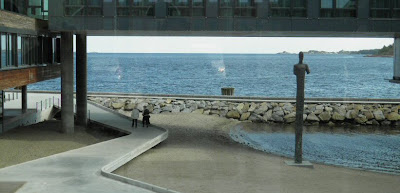The day I delivered the thesis (August 1st), I was back on the same teaching job I had before the PhD-study – however teaching is never the same. My main teaching responsibilities this fall are related to two groups of students: the one in a group of 18 undergraduate art and crafts students, the other is a group of 19 master degree students studying “pedagogical texts”. One might immediately wonder: What is a pedagogical text? Am I not an A&C teacher and how does my teaching relate to pedagogical texts? These questions are more than relevant at the point when both my students and I are searching for appropriate definitions of pedagogical text that can appropriately include arts-based approach to education.

In the broad definition of “text”, as used by the researchers at Vestfold University College, a pedagogical texts is any kind of physical object that can be used in a pedagogical purpose. This, of course, includes text books, but also art materials, costumes used in drama education, or accordion used in music education. But what about a dance floor and the classroom space – are they also “pedagogical text” - or are they rather pedagogical contexts? Could anything used by a teacher in pedagogical purpose become a pedagogical text – disregarding what the pedagogical goals are? For instance, if the purpose of education is to stimulate students’ imagination, could a fairy-tale as well as a non-figurative sculpture, become a pedagogical text?
Meeting the two groups of my students, I bring with me my experiences and unanswered questions from one group to another; The group of A&C students have been exploring three-dimensional materials and reflecting about their experiences from the creative work. Many found it difficult to assign words to their aesthetic choices and intuitive actions. To inspire their future work with research on own creative work, artist-researcher Grete Refsum was invited to present her artistic processes.

Listening to Grete Refsum I was thinking about how fantastic piece of pedagogical text her presentation was: It was a pedagogical text that seemed to have helped
her structure her thoughts, past ideas, feeling and experiences in order to present them. On the other hand, her presentation was a well-functioning pedagogical text addressing the students and meeting them at the point they needed examples of well documented creative processes.
Grete presented her work with 17 pictures (part of the same art work) in chronological order: from the invitation to exhibit, exploration of the specific room shape and function, choices of the themes, materials, techniques, shapes, lines, compositions and so on. While she was talking and showing images, I got more aware of the complexity of her creative process – in fact I could identify at least four different processes that seemed to exist simultaneously, and interweave:
1. The process of studying the space, the physical contexts where her art would be exhibited; She seemed to have audience on her mind while she was planning.
2. The process of background research that supported her thematic choice of combining Western religion (Christianity) and Eastern (Kina) ideology and culture. This research would lead to her choices of symbols, materials, forms;
3. The process of exploring materials, techniques and practical possibilities of composing with the specific material combinations;
4. And the process of her traveling and collecting personal experiences one might think of as separated from her art, but in fact essential for it.

When I view Grete’s lecture as a pedagogical text, I wonder where did such pedagogical text start and end; The lecture would not be possible if she had not for years worked on her art project, if she did not experience, reflect, take choices… Additionally, the pedagogical goals developed during her and mine discussion before the lecture about what the students needed. At this point, when the students got an assignment to verbalize their experiences and seemed to struggle with it, Grete’s lecture hopefully meet them at the right moment where they had experienced some challenge, but still not become too frustrated. Grete’s lecture could possibly help them to extent the zone of their proximal development, instead of giving up. This is up to them to evaluate: What do you say, my students?
Relevant link: International Association for Research on Texbooks and Educational Media
(IARTEM)
 Stern (2004) says that life is always lived in the present moment. It cannot be different. Unable to release ourselves from the constant flow of time (except in dreams and some other extraordinary events) we are unable to get back to exactly the same place in time; contexts are always new. Each moment is unique and unrepeatable. Each experience is unique, but only when we dare to live it… in the unique, present moment.
Stern (2004) says that life is always lived in the present moment. It cannot be different. Unable to release ourselves from the constant flow of time (except in dreams and some other extraordinary events) we are unable to get back to exactly the same place in time; contexts are always new. Each moment is unique and unrepeatable. Each experience is unique, but only when we dare to live it… in the unique, present moment. The images (still and in motion) are captured from exactly the same place, on days with no wind - amazing how the leaves were falling all by themselves. The fourth time I intended to take a photo, the trees were gone…
The images (still and in motion) are captured from exactly the same place, on days with no wind - amazing how the leaves were falling all by themselves. The fourth time I intended to take a photo, the trees were gone…
































